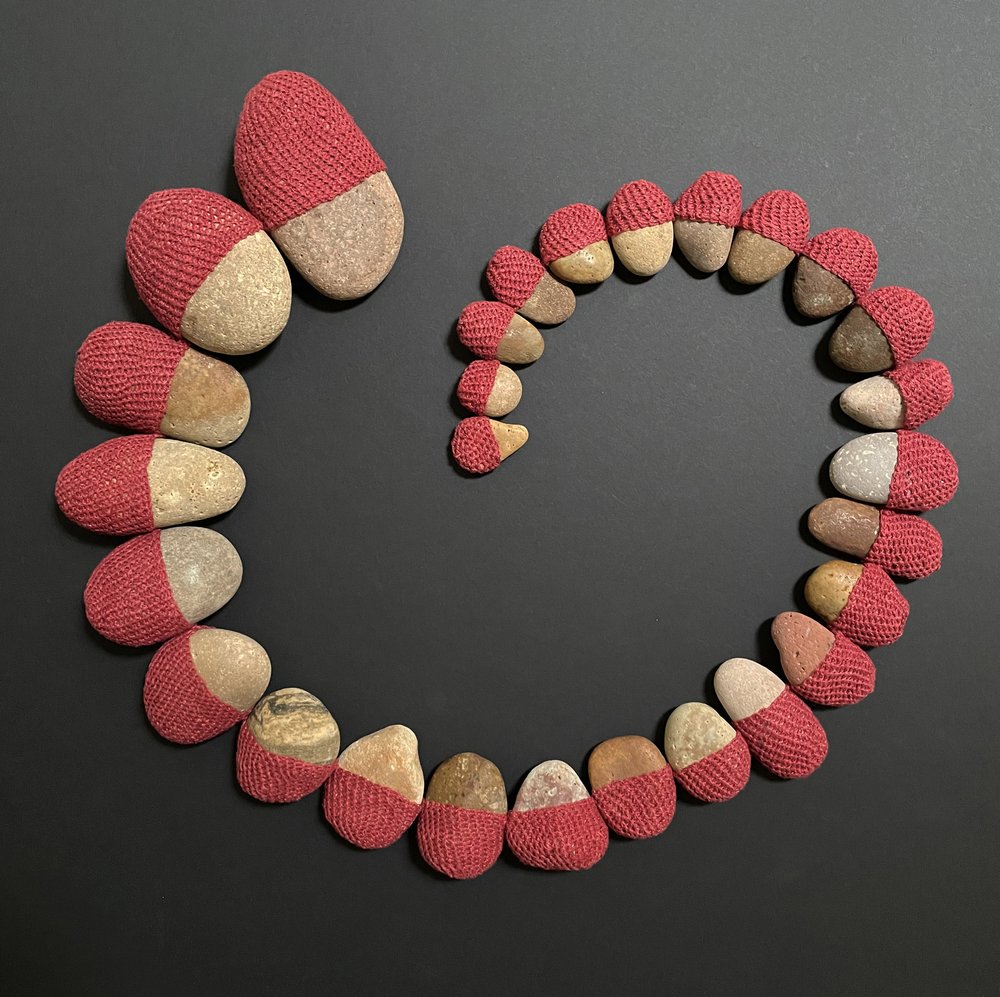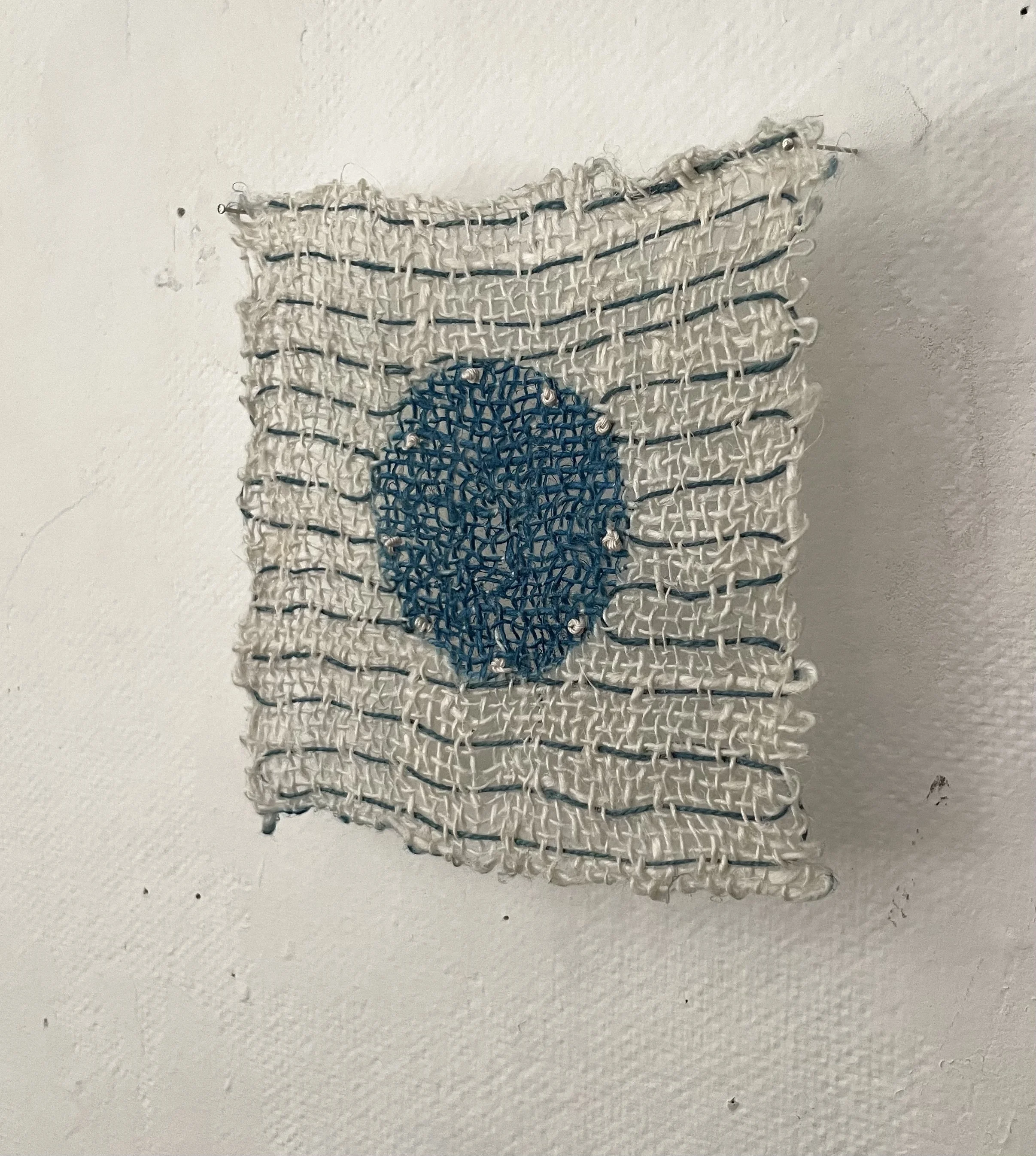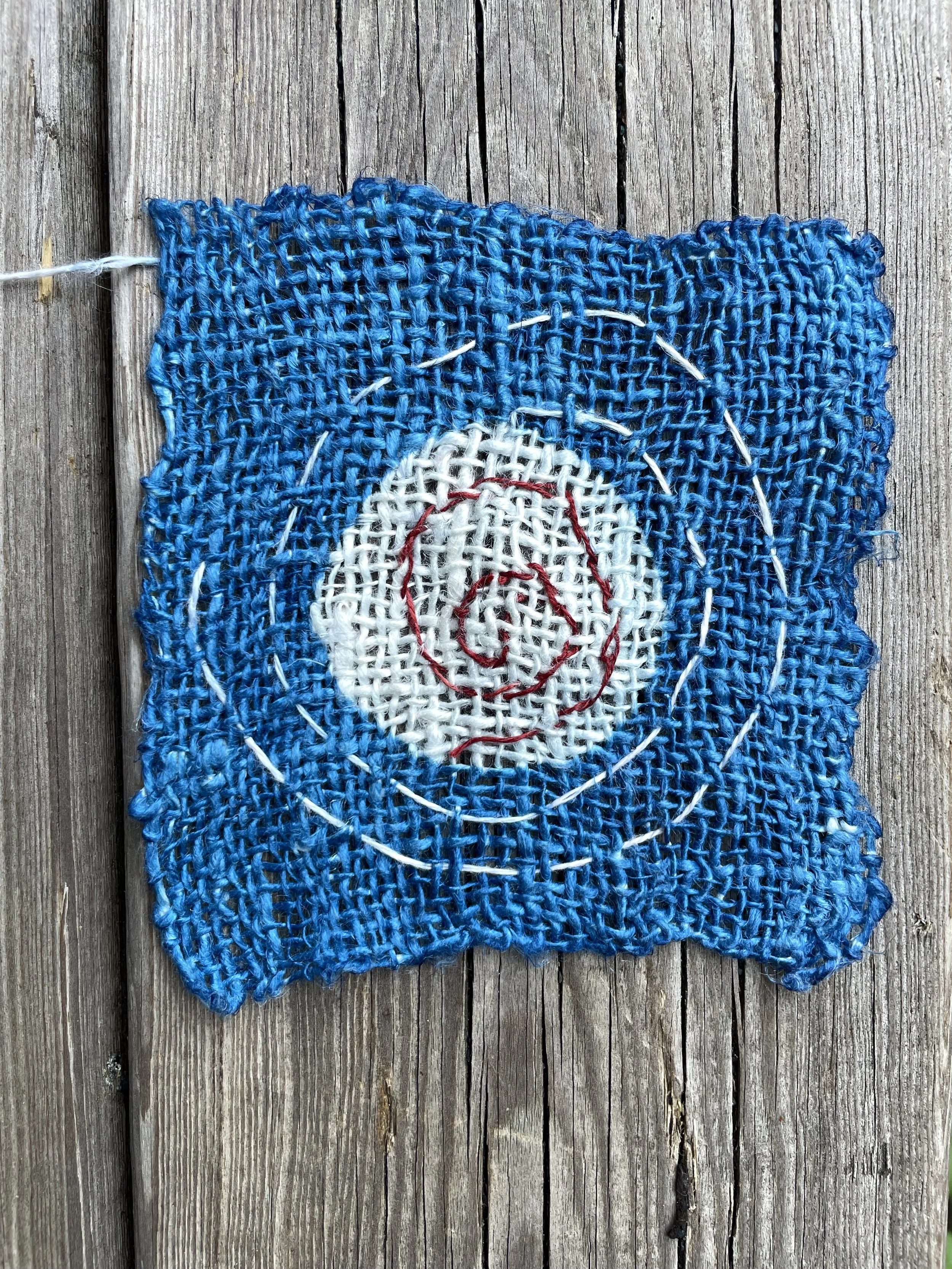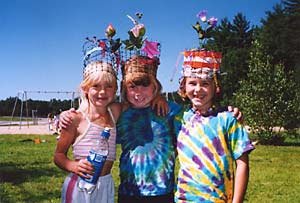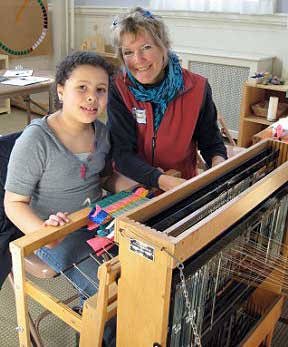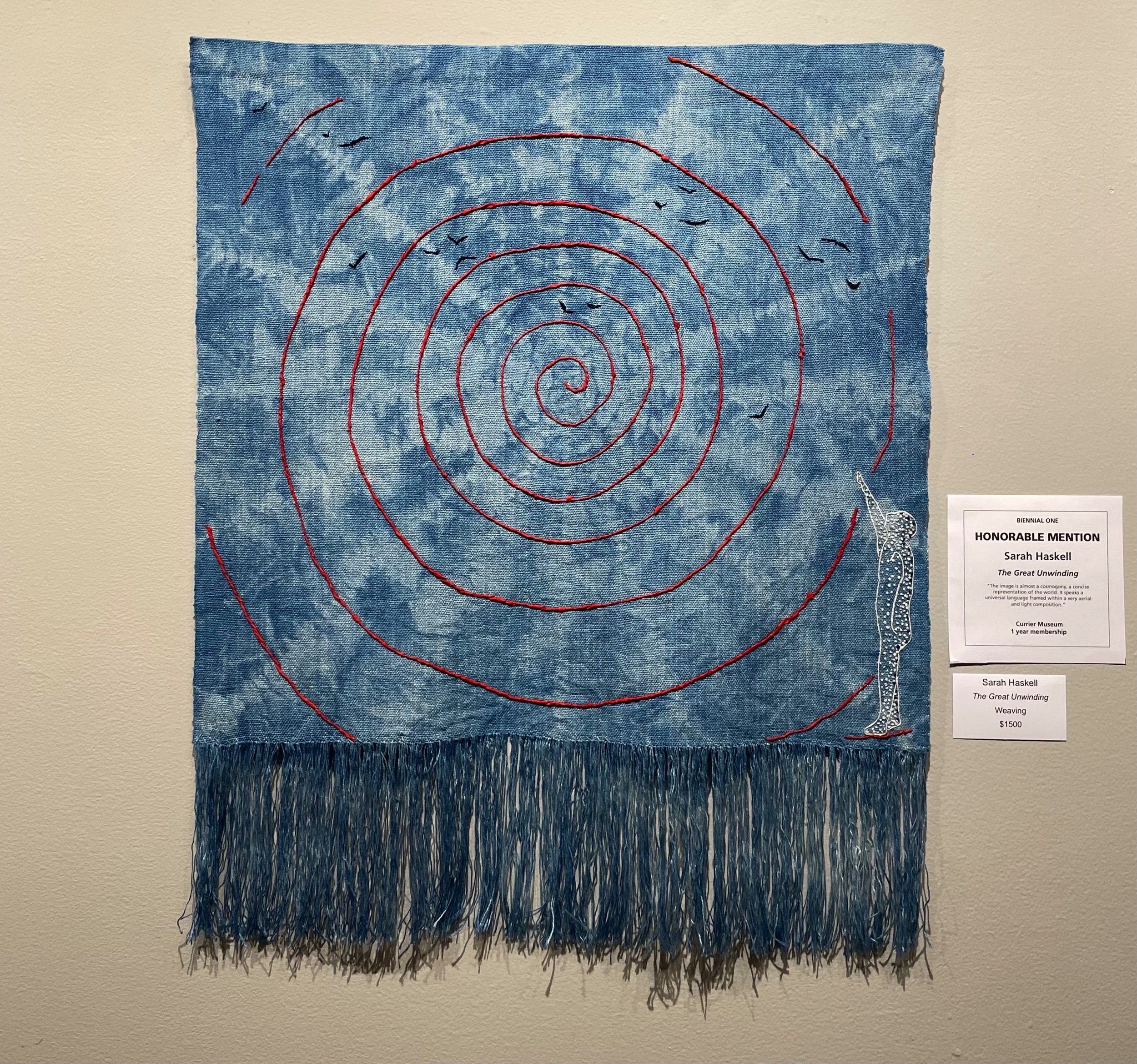In the beginning, I designed "Woven Voices: Messages from the Heart" as an effort to bring more positive energy to the world through a creative doorway. This international community art project was inspired by Tibetan prayer flags, Shinto paper prayers, and the Buddhist concept of impermanence. Reflecting back on this four year endeavor, I see that in parallel with my efforts to change the world, I have changed myself. In a manner of speaking I have unconsciously embodied Gandhi:"Be the change you want to see in the world." [1]
The image of the spiral rings true to illustrate my path of learning from "Woven Voices: Messages from the Heart". Throughout this four year project, lessons would appear with a slight air of familiarity. Round and round, I revisited these lessons, practicing the art of repetition, seeking fresh wisdom and insight each time I encountered a recognizable lesson.
The first lesson was that this project had a life of its own, I was simply the facilitator. Originally I had envisioned a six to eight month time table, during which I hoped to collect a few hundred messages of hope and peace, then I would weave them into a series of prayer flags and give the flags back to the message writers.
Within two months of launching the project, it became clear that I could not adhere to this self-created time table. "Woven Voices: Messages from the Heart" was being fueled by a need from a larger community consistently longing for connection, justice and well being for all. My call for messages of positive intent had sparked interest and participation from people all ages and corners of the globe. My challenge was to figure out how to adjust my vision for the project and to accommodate the interest in others to participate at multiple points of entry. I began to understand that "Woven Voices" had become a classroom and my role was that of both student as well as educator. The first of many lessons was the art of letting go and honoring what shows up. Through this lesson, the teacher-me asked the student-me to be present, to listen and to honor the energy that my invitation for messages of peace and hope had elicited. As mentioned in the three founding objectives for this project, "Woven Voices" was not about furthering my career but about bringing positive energy for the greater good of the universe.
As I bring closure to "Woven Voices" I have teased out nine core lessons that were the foundation of my personal and creative growth from this project, in other words nine lessons of art and healing.
The 9 lessons from
"Woven Voices: Messages from the Heart"
1. The lesson of letting go: the ability to suspend attachment to something or someone.
2. The lesson of authentic vision: commitment to an idea or attitude that is true to one's nature.
3. The lesson of showing up: to be present in mind, body and spirit even in the face of fear and the unknown.
4. The lesson of no expectations: the ability to focus on and trust the process rather than the product.
5. The lesson of holding space: the ability to create a container for growth that offers no attachment to outcome and invites possibility.
6. The lesson of the present moment: the ability to be firmly rooted in the here and now.
7. The lesson of faith: the ability to have trust in a vision, an ideal or a person.
8. The lesson of impermanence: to understand that all of life is in a constant state of change.
9. The lesson of mystery, the unseen: the ability to accept the there are some things in this material world that cannot be seen and cannot be quantified.
All of these lessons can be applied to making art and all of these lessons can be applied to a path of healing. These nine lessons are fundamentally linked together like a prayer flag woven with fragments of this and that. Over the four years I guided "Woven Voices: Messages from the Heart" these lessons spiraled around me.
Upon examination these lessons hold wisdom that is found at the core of many world religions. The lesson of letting go is at the heart of Buddhism. Tibetan monks create a sand mandala for 5 or 6 days, only to sweep it into a brass urn and pour the sand into the closest body of water; this is the practice of letting go. Over and over again, I would weave prayer flags and then send them off, often with no response or acknowledgement of their arrival.
In the winter of 2010, I traveled to South Africa staying in the Cape Town area for a month before I embarked on a trans-Atlantic sailing voyage to the Caribbean island of Barbados. While in Cape Town, I made contact with a peace and justice organization in the Johannesburg/Soweto area and I sent them over 30 Woven Voices prayer flags. I eagerly awaited a reply that they had arrived. I waited for three weeks. I made phone calls, sent emails and I put in a "lost article" claim through the South African Post Office. Nothing. No one had seen them or received them by late January when I had to set sail west across the Atlantic. Upon my return home in late March, I emailed the Soweto contact person and again heard nothing. Slowly I began to notice how attached I had become to these prayer flags going to the place I had sent them. And then ever so slowly I began to shift my attention to just letting the flags go; go to wherever they needed to do their good work, whether that was a landfill in Johannesburg or a postal worker's private quarters. I let go. I let go of needing to know and I let go of trying to control the outcomes. I began to trust the process ~ to embrace the lesson of no expectations.
Then one morning in mid-June I had a very sweet surprise when I opened my email in-box. There I found a note and photos from an Phaphama, the organization in Johannesburg, South Africa that I had sent the prayer flags to in January. In the photo, two of the prayer flags were being given to a women's group called Kopanang, an embroidery project run by women who are infected by HIV/AIDS. Little did I know that the ripple of love and peace that began months ago with the gathering of messages was weaving magic thousands of miles across the globe.
The lessons of faith and authentic vision manifested at that moment. I came to understand that my primary job was to hold fast to my authentic vision, the original idea that ignited this project and to invest in the faith that if I did hold steady with my eyes and actions on this authentic vision, then everything would fall into place. I began to trust that my primary effort needed to be on the process, carrying out the core work of the project: the collecting and reading of messages, the weaving of flags and the sending of flags around the world. This work was my authentic vision revealed in physical activity. Once the prayer flags were given away, I had to let go with the faith that I had done good work grounded in my authentic vision.
The lesson of showing up was offered to me each time I went to Portsmouth NH to publicly read messages of peace and hope. I recall the very first time I went to the town's Market Square to do a public reading; I felt nauseous, nervous and close to tears. I was convinced it was a foolish idea and that no one would come to join me. Two hours later, over 400 messages had been read and over 100 people of all ages had participated in the event. With the support of a clear and authentic vision, hundreds of people and the faith that this public reading was the right thing to do, I had shown up at noon on July 8, 2008. According to Angeles Arrien's "Four Ways to Wisdom" I had taken up the mantle of the Warrior. She writes: "The task of the warrior is to show up, to be visible and empower others through example and intention." [2]
Inherently entwined with the lesson of showing up, are the lessons of holding space and no expectations. The initial lesson of "Woven Voices" was that of letting go of my agenda, adopting an mind-set of no expectations and trusting the process that I had initiated. Each time I arrived at Market Square to read, I challenged myself to show up with an attitude of no expectations and to simply hold the space for what needed manifest. Each time I opened my studio for the community weavers, I held the space with no expectations, simply being present unconditionally to what and who arrived to join me in carrying out the project vision.
It was during one of my intensives at Wisdom University that I came first to know the lesson of the present moment. Angeles Arrien would emphasize throughout her 5 day course, that the present moment is the most powerful, potent creative place to be. To paraphrase Arrien: "The present moment course corrects the past. The future enters us long before we are aware of it; in fact the present moment holds the seeds of the future." [3]Being present is perhaps the most important consistent action I can choose. The power of change and transformation reside in the present moment.
As I traveled through the different stages of working on "Woven Voices: Messages from the Heart" there were be numerous occasions when I would suspend my frequent musings on past actions and agendas for the future. I would anchor myself in the present moment by listening, inhaling, feeling, tasting and observing all that was offered in that brief and fleeting space. This pause, this grounding action would "course correct" my path to keep me on track towards my authentic vision. I discovered that there is all the time in the world in the present moment.
The lesson of impermanence was a core principle from the outset for "Woven Voices: Messages from the Heart". Modeled on the horizontal style of flags Tibetan prayer flags called “Lung Ta” which translates to mean “Wind Horse”, the community woven prayer flags are installed outside. When the wind blows, the prayer flags flap in the breeze and the sacred messages are carried out on the wind to all beings. The hand-woven prayer flags are meant to deteriorate slowly over time to release the blended messages, creating a universal prayer of compassion, wisdom and renewal. I believe that these prayer flags are impermanence made visible.
Unquestionably embedded with the lesson of impermanence is the parallel lesson of letting go. Just like the Tibetan monks who make sand mandalas and then release them to the ocean, we (myself and the community weavers) made over 1,300 prayer flags and gave them away. Repeating this lesson multiple times, creating beauty, releasing it, again and again had a subtle way of shifting my spirit. I did not fully understand the changes that had transpired until a heartrending event occurred in my life.
August 18, 2011 my dear brother was killed in a tragic construction accident. Weston was my only brother and my ally. He was my traveling companion to South Africa last winter, sailing back across the Atlantic Ocean to Barbados. In a split second he was gone. The lesson of impermanence confronted me on an unparalleled scale. I believe that I was able to see my way through those first dark days of shock and grief for several reasons, one of them being that I had been practicing the lessons of impermanence. These lessons enlightened me to consider that even though my brother's physical body was no longer present, his energy was/is is still present. I have come to believe that impermanence does not mean that something is here and then it is gone. I believe that impermanence implies transformation or change, and that change is an inevitable part of life in this physical world. I believe that my brother's energy has transformed from a physical plane to plane that is unseen, not visible.
This lesson of the unseen or mystery embraces all the afore mentioned lessons. I believe the eight lessons of impermanence, letting go, showing up, holding space, authentic vision, faith, the present moment and no expectations are braided together to shape the lesson of mystery. Accepting mystery or embracing the unseen is an ability to accept that there a force or energy that is not quantifiable. This force is ever changing, ever present, a container for possibility with unconditional acceptance for what is. I believe that healing and creativity are anchored in this mystery, this basket of woven of these nine lessons. As John Muir said: “When one tugs at a single thing in nature, he finds it attached to the rest of the world."[4] Each of these "Woven Voices" lessons is akin to a thread; a thread intricately woven into a whole cloth of learning, growing and healing.
As a visual artist for over 45 years, I have used my creative efforts to explore these nine lessons. My studio has been a refuge for honoring my authentic vision, a platform for showing up and letting go of expectations, a sanctuary for holding space for mystery and inviting the unseen, a temple for embracing faith, a laboratory to explore impermanence and an haven to anchor me in the present moment. Guiding "Woven Voices" has allowed me to take these lessons and extend them beyond my studio walls, to offer my experience and the insight I have gained to others.
But perhaps there is a tenth lesson to be learned here: the lesson of intentional closure. In the spring of 2011, after three plus years of guiding "Woven Voices", I felt it was time to bring this community art project to an honorable and intentional closure. One of the characteristics of a good artist is to know when to stop working on a piece of art; to know when enough is enough, to know when a piece is done. In May of 2011, I knew that the time had come for "Woven Voices" to draw to a close. So in early June I designed and launched a fund raising effort through Kickstarter, an on-line pledge system for creative projects. I set a goal of raising $4000 in 30 days. These funds would be used to carry the overhead to complete the project, to weave 1000 prayer flags and to install hundreds of them at Ground Zero on the 10th anniversary of 9/11, while distributing the rest worldwide. Through Kickstarter I successfully raised the necessary funds to support an intentional and honorable closure. Contained within this box of evidence are the Kickstarter documents: the project initial posting and project updates.
Parallels between art and healing are to be found in all these ten lessons. My original intent for "Woven Voices: Messages from the Heart" was to design a community art project that would offer a healing opportunity to all people, regardless of geographic location, income, artistic skill or physical ability. As the first months of the project unfolded, I began to see that my desire to heal/change a larger community always seemed to point back to me and the lessons and healing that I need. Over the years of working on "Woven Voices" it became clear to me in a very concrete way, that my healing and global healing are intricately woven together and that one pathway to healing is through art. I believe that I am a microcosm of the universe and if I find that making art heals me, makes me feel more resilient, more compassionate and more whole, then it must be so for others.
As a weaver, my work is building webs , creating connections. Weaving is a process where individual units are put together in a pattern or structure to create a whole. As an artist/healer I use my skills to create visual art works and opportunities that nurture, support and inspire connections between people, animals, nature and the invisible mysteries of this world.
I believe that just as the threads of my woven art pieces are intrinsically linked together, our human lives are linked together in a manner that makes our destiny inseparable. As Chief Seattle said "Humankind has not woven the web of life. We are but one thread within it. Whatever we do to the web, We do to ourselves. All things are bound together. All things connect."[5] As I continue to grow, change and heal, so too, you are growing and healing. If I help you grow, change and heal, I am better for this too. Our lives are woven together.
"Woven Voices: Messages from the Heart" has officially concluded. But as in any spiral path, there is no real ending, only a pause. The ten lessons from "Woven Voices" will continue to shape my work using art as a vehicle for healing, change and building community. I believe that my art and ability to use my creativity to lead people to grow and heal is a direct manifestation of my deep compassion for my fellow beings.
When the work of individuals is fueled by love, guided by intuition and grounded in their authentic voice, their unique potential, this world will be moved towards peace and justice for all. In the words of Kahlil Gibran:
"And what is it to work with love?
It is to weave the cloth with threads drawn from your heart,
even as if your beloved were to wear that cloth.
It is to build a house with affection,
even as if your beloved were to dwell in that house.
It is to sow seeds with tenderness and reap the harvest with joy,
even as if your beloved were to eat the fruit.
It is to charge all things you fashion with a breath of your own spirit,
And to know that all the blessed dead
are standing about you and watching.
........Work is love made visible".[6]
References
Arrien, A. (1993). The four-fold way: Walking the paths of the warrior, teacher, healer, and visionary. [San Francisco]: HarperSanFrancisco.
Arrien, A. (2009, July). Lecture presented at Graduate Intensive: The Nine Muses: in Wisdom University, Oakland, CA.
John Muir Quotes (Author of My First Summer in the Sierra). (n.d.). Share Book Recommendations With Your Friends, Join Book Clubs, Answer Trivia. Retrieved from http://www.goodreads.com/author/quotes/5297.John_Muir
Khalil Gibran Quotes - BrainyQuote. (n.d.). Famous Quotes at BrainyQuote. Retrieved from http://www.brainyquote.com/quotes/authors/k/khalil_gibran.html
Seattle, Jeffers, S., & Tehon, A. (1991). Brother eagle, sister sky: A message from Chief Seattle. New York: Dial Books.
Talk:Mohandas Karamchand Gandhi. (n.d.). Wikiquote. Retrieved from http://en.wikiquote.org/wiki/Talk:Mohandas_Karamchand_Gandhi
[1] Talk:Mohandas Karamchand Gandhi. (n.d.). Wikiquote. Retrieved from http://en.wikiquote.org/wiki/Talk:Mohandas_Karamchand_Gandhi
[2] Arrien, A. (1993). The four-fold way: Walking the paths of the warrior, teacher, healer, and visionary. [San Francisco]: HarperSanFrancisco.
[3] Arrien, A. (2009, July). Lecture presented at Graduate Intensive: The Nine Muses: in Wisdom University, Oakland, CA.
[4] John Muir Quotes (Author of My First Summer in the Sierra). (n.d.). Share Book Recommendations With Your Friends, Join Book Clubs, Answer Trivia. Retrieved from http://www.goodreads.com/author/quotes/5297.John_Muir
[5] Seattle, Jeffers, S., & Tehon, A. (1991). Brother eagle, sister sky: A message from Chief Seattle. New York: Dial Books.
[6] Khalil Gibran Quotes - BrainyQuote. (n.d.). Famous Quotes at BrainyQuote. Retrieved from
http://www.brainyquote.com/quotes/authors/k/khalil_gibran.html
